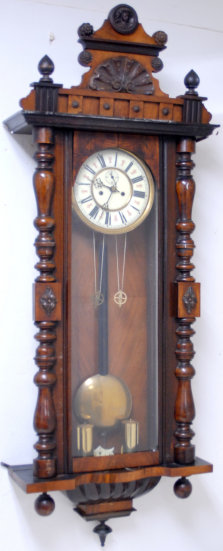

446. $500
Waterbury Clock Co, Waterbury, Conn., cleaned/refinished, now
aged to a medium or golden oak color. If you like oak, you will like this clock. It is original top to bottom except for the replaced
paper dial. The pendulum bob is correct, looks great, and runs the clock properly. The 8-day time only movement has been serviced
and is in great running order. The hands, and all the finials are correct. It has a signed beat scale inside, a complete paper label
on the back, and all finials and case parts are original. You will not find one much nicer. True, it would be nicer if it had the
original finish, otherwise this one is a very good example. Ly-Waterbury #583. $750-$1000.

447. $300
“Birge, Case & Co. / Bristol, Conn.”, column and splat, Empire
style triple deck clock, ca 1833-1835. Eight-day strap brass movement with extended side arm, seat board mounted, strikes an iron
bell. The movement has been serviced and restrung, and in excellent running condition. Almost a complete paper label inside. There
is a good wood dial with mirror for viewing escape wheel, period hands, pendulum bob, and a pair of period 8-day iron weights. All
three glasses are replacements, the paintings copied from originals, and escutcheons, locks, and a key in each door. Full turned columns,
turned ball feet, and a very nice carved fruit basket crown on top. The returns and caps are good and it has the original covers for
the top. The mahogany veneered case is 38” high, clean, and overall in very nice condition. There are some small repairs that need
to be made in a couple of places on case edges. A great early clock for this minimum. $350-$500.

448. $300
“C. & L. C. Ives, Bristol, Conn.”, ca 1830-1836. Lawson
Cheney Ives was in partners with his uncle, Chauncey Ives. I can find no references indicating they were related to Joseph Ives, but
in the small town of Bristol they surely were. One of the first clocks they made used a strap brass movement invented and patented
by Joseph Ives, and subsequently licensed to other clockmakers in the Bristol area. Reference: Ives book by Roberts, page 99. Movement
has been restored, bushed, and in great running condition. Mahogany veneered case is 38 inches tall, good veneer all over, but you
will find a few small nicks on the back edges, and some light hauling scratches on the edges. The fruit bowl splat has good gilt,
columns and ball feet have new gilt but well done. Two door locks with ivory escutcheons, and a key. The middle and bottom glasses
are extremely fine paintings by Tom Moberg. The two iron weights are correct, and of course we cannot be sure about the pendulum bob
and key as to originality. Excellent painted wood dial with mirror inserted, and a pair of period hands. There is no label but the
clock was identified by the movement. There is very little research that I can find about this maker. The best is Bulletin Supplement
#6, 1970, “Some Observations Concerning Connecticut Clockmaking, 1790-1850”. $400-$600.
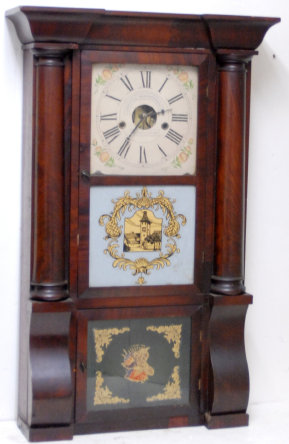
449. $150
“Forestville M.F.G Co. / Bristol, Ct. / U.S.A.”, signed on the
movement of this Giant Empire style column and cornice clock, ca 1846. They made the same clock in various sized cases and called
them simply, “column and cornice”. This mahogany veneered case is 31 ˝ inches high and a reasonably nice-looking case all around.
The bottom glasses are old, original to this case, cannot say, but doubtful. The case has two doors, both with turn latches, large
half columns, sleigh front base, and of course the nice cornice top. The signed acorn 8-day movement has been restrung but I would
replace the cords to be safe. Large 8-day iron weights, coil gong, old pendulum and hands complete the clock. The wood dial has been
repainted at some point and the added the name, “Forestvill, Manufacturing Co. Bristol, CT.U.S.A.” to the dial. Note the spelling
of Forestville. As you can tell there is no label. I hand tested the movement and it is operable. I did not hang the weights. $200-$400.
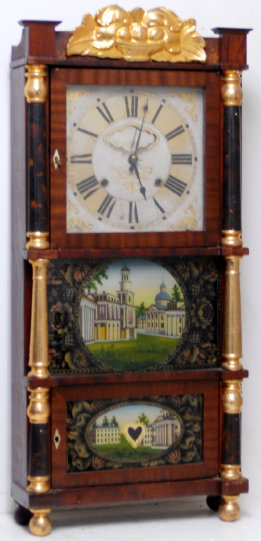
450. $250
“Birge & Fuller, Bristol, Conn.”, double decker Empire style shelf clock sometimes called a modified triple decker, ca 1844-1848. Note this case still has the large strap brass movement. They changed to the smaller strap movement about the time of the changeover from Birge, Mallory & Co. to Birge & Fuller. This strap movement is the one designed by Joseph Ives a few years earlier. The 8-day, two weight movement is complete and operational. The mahogany veneered case with full turned columns and a great original carved eagle top, round feet underneath and has replaced glasses that are copies of originals. It also has a very good repainted dial by The Dial House. The hands are period as is the pendulum bob and one weight and a second weight is a replacement. It has a nice paper label inside and a coil gong. The case is 38 inches tall and appearance wise is a really nice-looking clock on the mantel. Upon very close examination you will probably see where a piece of veneer has been chipped and glued back in place, and probably an edge nick or two on the edges. There are many articles and books about these early American clocks. Lee H. Davis has a contribution in the NAWCC Bulletin, August 1997 that examines these clocks by Birge and Mallory, Birge & Fuller, Birge and Peck, and others. $300-$500.
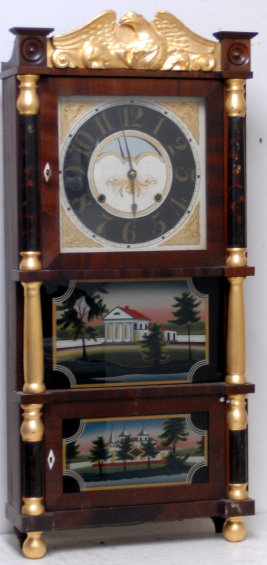
451. $300
“Birge & Gilbert, Bristol, Conn.”, triple decker shelf clock, ca 1837. This company was in business only one year. Restored triple decker 8-day clock, has two doors, and a middle stationary glass. The mahogany veneered case has full columns; a carved eagle splat, turned feet, and has been restored, i.e. cleaned and polished. Top is complete with chimneys and returns. They used bright gold paint on the capitals and bases, the middle columns, gold leaf ball feet, and the carved piece on the splat. The two old glasses are replacements, or repainted on the old glass. The veneer and finish on the 38” high mahogany veneered case is good, if any repairs or patching was done you do not notice the repairs. Excellent wood dial with mirror insert, and black chapter ring, period hands, and pair of old iron 8-day weights, old bob, and keys for door locks. This is the only maker that used a black dial. Doors have ivory escutcheons, and working locks and key. A paper label inside covers the backboard and is near perfect. Strap brass 8-day movement has a side arm extension, and is not signed. The weight cords are good, pulleys intact; movement mounted to slide in wood seat board, and is in running order and striking a coil gong. This is a very attractive clock, in very nice overall condition, running as it should, and a good example of the early triple decker clocks. $500-$750.
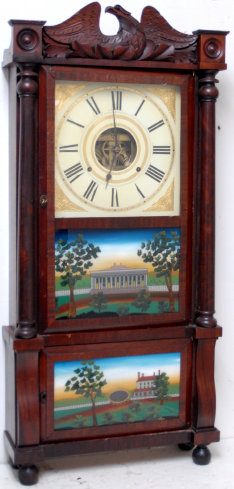
452. $150
“Forestville Manufactg. Co., Bristol, Conn.”, eight-day Empire
style column and cornice shelf clock, ca 1841. The mahogany veneered case is 37 inches tall, overall in good condition, a few expected
nicks and bangs, no significant repairs of consequence. The top glass is a replacement, the two painted tablets by Tom Moberg on the
bottom were copied from original tablets. Full turned columns, sleigh front and turned round feet underneath. Top door has key lock,
no escutcheon; bottom door has ivory escutcheon, lock and key. Inside is a very good label, coil gong, original pendulum, and pair
of large/heavy iron weights. They are flat rather than the usual square type we normally see. It has a good wood dial and old hands.
The 8-day brass movement is in good running condition. Reference: “Jonathan Clark Brown and the Forestville Manufacturing Company”,
by Kenneth Roberts and Snowden Taylor. $200-$400.

453. $300
“C. & N. Jerome, Bristol, Conn.”, triple deck case, ca 1834-1839.
Brothers Chauncey and Noble began making strap brass movements about 1836 so that would date this clock 1836-1839. This 38-inch-high
mahogany veneered case is decorated with gold gilt on the capitals and bases of the full columns, the round ball feet, and the eagle
splat. There are ivory escutcheons and locks on the two doors, but no key. Most of the label remains on the backboard, there is a
coil gong, and heavy iron weights. The 8-day strap brass movement with extended side arm seems to be a variation of the Ives movements
we have been writing about in many of the clocks in this auction. The wood dial is almost too perfect on the front but has had additions
or rearranging of slats on the back, and some extra holes. The two painted tablets by Tom Moberg are copies of originals. Reference:
“From Rags To Riches To Rags / The Story of Chauncey Jerome”, found in the NAWCC Bulletin Supplement #15. $300-$500.
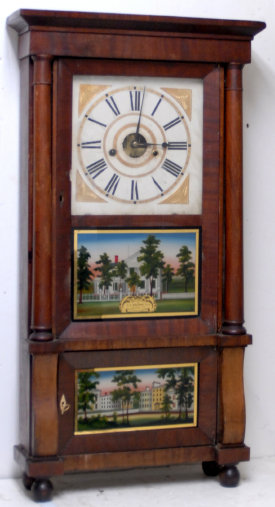
454. $250
German 2 weight Vienna Regulator made by the Kienzle Clock Factory
in Germany. The 8-day movement is signed with their “wings” trademark. The case style is indicative of those made in the late 1800’s
and early 1900’s. The beautiful walnut case is 48 inches tall with the original top that is removable, and the elegantly turned columns
on the sides. Look closely at the round piece on the very top. It is a carved piece of a man who looks a little like Sir. Walter Raleigh?
The case has glass sides, two correct brass weights, brass pendulum on a wood stick, brass pulleys, porcelain beat indicator, and
the two-piece porcelain dial with original hands. The movement has been serviced and is in excellent running condition. $300-$500.
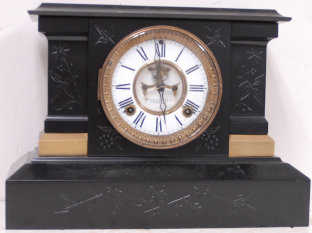
455. $50
“Ansonia Clock Company, Ansonia, Conn.”, enameled iron case mantel
clock, ca 1904. This clock was their “Vienna” model and originally had metal feet and metal end ornaments. The case has been refinished
covering the bright incised decorations over the front. It has a signed two-piece porcelain dial with a visible escapement mechanism
and correct hands. The dial and movement are worth twice this minimum of $50. The iron case is 14 inches wide and 11 inches high.
It has a proper medal door on the back, allowing access to the movement. It is running and striking hours and half hours on a gong.
Ly-Ansonia #1011. $100-$200.
